Menu

Did you know that U.S. agricultural exports grew by 2.1% each year from 2013 to 2023? However, imports increased by 5.8% in the same time. I, working in this field, understand how crucial it is to maintain this balance when selling abroad.
Keeping up with changing rules and meeting market needs are keys to success. The US leads in exporting agriculture, reflecting our innovative strategies. For those looking to break into the US market with agricultural goods, these points are critical.
If you’re interested in exporting agricultural products, you need to understand the basics. This includes knowing the export rules, studying the market, and building strong relations with trade partners. Knowing these things well helps you start exporting smoothly.
It’s important to meet what consumers want. As more people join the middle class worldwide, they seek more foods like dairy, meats, fruits, and vegetables. Exporters must pay attention to these changing needs and adjust their products.
Exporting food abroad has gotten easier through various trade agreements. For example, the US has seen a big increase in selling food to China. The US now sells about 20% of its food production overseas, showing a stable and growing market.
Between 2013 and 2022, about 23% of US non-manufactured and 21% of manufactured farming goods were sent abroad. This growth has helped the US economy and created many new jobs. In 2021, every billion dollars of US food exports meant almost 7,000 jobs were supported.
The rise in food exports shows how the agriculture sector can adapt. US exporters can handle changes in prices or new consumer trends. Knowing these aspects well is key for doing well in the agricultural export market.
Recently, the U.S. agricultural sector has seen big changes. There has been growth and changes in different areas. The U.S. saw a 2.1% yearly growth in agricultural exports from 2013 to 2023. Although the total value of exports fell to $178.7 billion in 2023, the sector remains important for the economy.
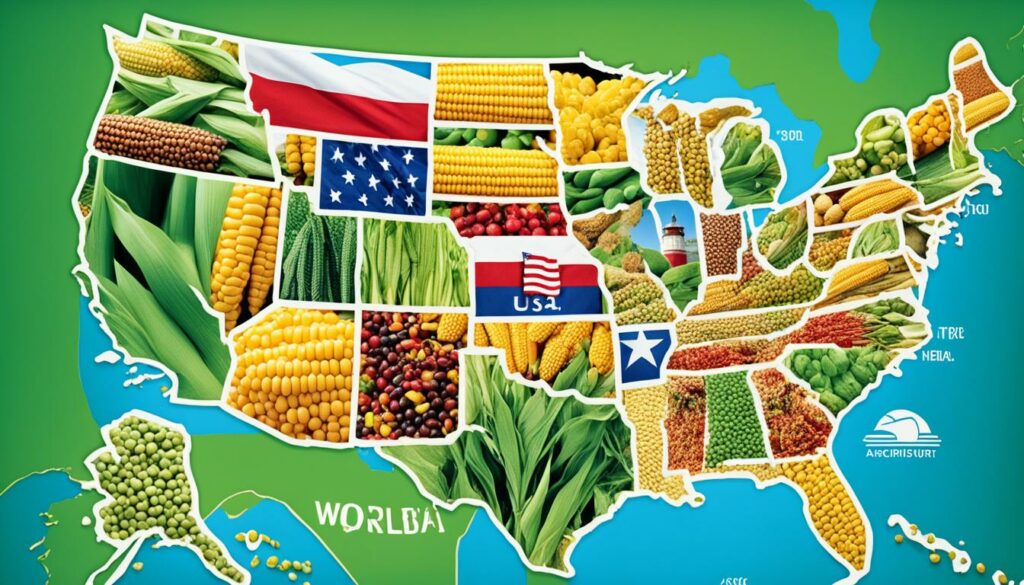
The U.S. exports a wide range of agricultural goods. This includes grains, feeds, soybeans, and various livestock items. Dairy, meats, fruits, and vegetables have also done well. These products are key to the U.S. economy and its role as a top exporter.
Looking at trade partners is key to understanding U.S. exports. The top five markets made up 64% of exports in 2023. Canada and Mexico are crucial, supplying the U.S. with agricultural goods. From 2017 to 2021, they provided products worth an average of $30.9 billion and $25.5 billion respectively.
The European Union imported $28.0 billion worth of U.S. agricultural goods in the same period. Together, East Asian and North American markets accounted for 60% of U.S. exports.
Conclusion
It’s important to look at export performance with China too. From 1997 to 2003, just 4% of U.S. exports went to China. This jumped to 15% from 2011 to 2022. The U.S. agricultural sector supported 1,230,000 jobs in 2021. This shows how vital these trade relationships are.
| Region | Value of Exports (2017-2021) | Value of Imports (2017-2021) |
|---|---|---|
| Canada | $30.9 billion | $30.9 billion |
| Mexico | $25.5 billion | $25.5 billion |
| European Union | $28.0 billion | $28.0 billion |
To wrap it up, the U.S. agricultural export sector is strong and evolving. It has many types of goods and links to important global partners. Being aware of these trends is crucial for those looking to join this market.
Market research is essential, mainly for agriculture exporting. Successful businesses make decisions based on information. It’s crucial to know your target markets and what they like.
To start, you must research global markets for farming goods. Smaller businesses should look at 3 to 5 markets. You can either collect info directly or use already available data.
Looking at U.S. export and other countries’ import numbers is key. This info shows what products are in demand. It helps you pick the best markets to export to.
Using U.S. export data can highlight top export spots. Also, focusing on facts like a country’s population and income helps a lot.
Knowing what consumers want is vital, especially in farming. It’s good to look deeply into different agriculture sectors. Check for areas with steady growth and less competition.
Use both direct (like surveys) and indirect (like reports) methods for research. This mix gives you a clear view of what consumers like. It’s the best way to build a strong export plan.
Keep an eye on market trends to stay ahead. Adapting your strategies ensures you meet consumer needs. This way, your products stay popular and your business grows.
Making sure your agricultural export obeys the rules is key for success in global markets. It’s essential to understand the export regulations. This keeps your operation legal and efficient. The USDA is central to this, giving detailed rules and advice, ensuring you follow both local and worldwide rules.
If you work in this field, checking sites like Regulations.gov is important. It lets you see and comment on federal rules. This open process makes sure everybody has a chance to understand and follow the rules.
Following the USDA’s animal and plant health rules is vital. It helps keep US farming healthy and makes sure our goods are not blocked by other countries. Meeting these high standards strengthens ties with other countries and means we follow the international law in agriculture trade.
It’s also crucial to meet the USDA’s crop insurance rules. They keep a close eye on these to stop any cheating. These rules and conditions for help follow with going by the insurance plan correctly.
The USDA works with the FDA and EPA on rules for biotechnology. These rules make sure all farming goods meet national rules. Also, making sure things are of good quality is a must. The USDA’s quality rules say food descriptions must exactly follow all relevant laws.
Exporting agricultural products means sticking tightly to USDA’s rules. This includes rules for how to weigh, label, and check crops and seeds. It’s important to double-check you’re following these rules completely.
To make these steps easier, it’s good to know about export papers like Export Licences and Destination Control Statements. There are lots of videos that can give more advice. They cover everything from selling items abroad to working out what list your item is on.
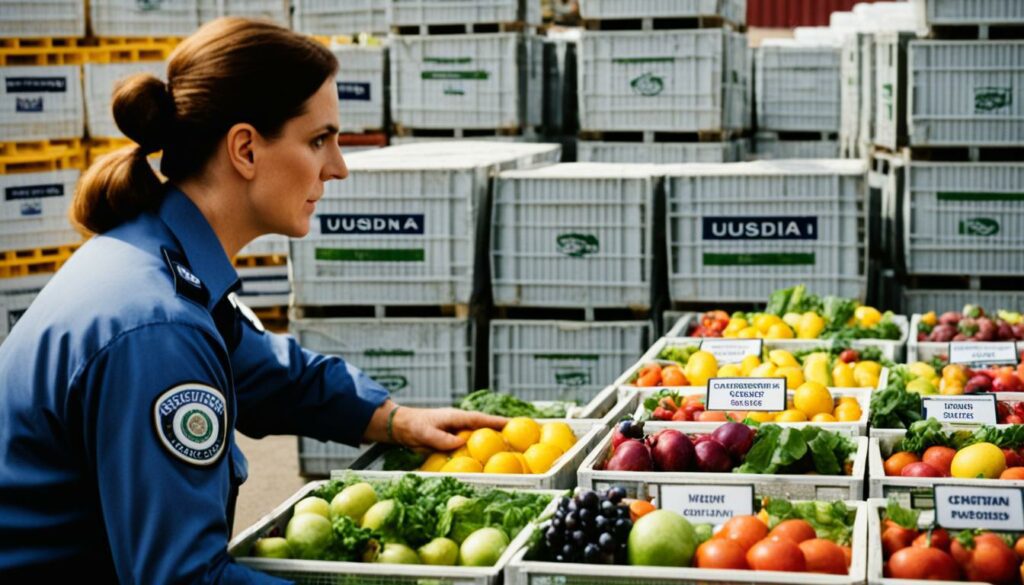
Each product has its own set of rules that you must get right. For example, Health Certificates for animals and other needed documents must be done perfectly. This is to meet rules from each country. Having the right insurance is also smart, in case something happens during shipping.
Learning about the details of international law in agriculture trade is crucial. It makes running your export business smoother and keeps you out of trouble. Remember, you need to follow strict rules like the ITAR by the Department of State and the EAR by the Bureau of Industry and Security.
| Regulation Entity | Focus Area | Key Compliance Points |
|---|---|---|
| USDA | Agricultural Export Compliance | Directives, Crop Insurance, Animal and Plant Health |
| FDA/EPA | Biotechnology | Regulatory Framework |
| Department of State | International Traffic in Arms Regulations (ITAR) | Export Licences |
| Bureau of Industry and Security (BIS) | Export Administration Regulations (EAR) | Dual-Use Items |
| Office of Foreign Assets Control (OFAC) | Embargoes and Trade Sanctions | Licence Requirements |
In short, it’s vital to follow the rules for exporting goods, laid out by the USDA and others. These checks make sure everyone is working to the highest standards. This way, trade between countries happens fairly and legally.
Managing export licences for agricultural goods is crucial. This ensures we follow export rules. Most items from the U.S. don’t need a licence to be sent abroad, but some do. Especially those under Export Administration Regulations for security and policy reasons.
For those in agriculture, knowing how to get export permits is key. Many products like EAR99 items can be sent without a licence. But, if the product’s destination or use is specific, a BIS licence might be necessary. It’s important to have a strong Export Compliance Program to make good export decisions.
In some cases, strict controls mean export licences are a must. Agencies like the U.S. Department of State watch over these licences. They might ask for a permit on goods such as agricultural items, arms, or even precious metals. Plus, organisations like the Nuclear Regulatory Commission handle special materials.
To get export permits, working closely with authorities is needed. Applying through SNAP-R, an online system, is common. But, to use it, you need a CIN. Remember, licences are not forever. They usually last about four years. So, timely renewals are essential.
Understanding how to get export licences is important for those in agriculture. By meeting all requirements, using the right channels, and having a good compliance programme, this can be done successfully.
The USDA provides many services to help U.S. agriculture exporters. Using these services, companies can do better in global markets. This means they can sell more abroad.
The USDA is big on helping companies sell their farm products abroad. They give help with marketing and finding good buyers in other countries. One key program, the Regional Agricultural Promotion Program (RAPP), has £1.2 billion to help promote U.S. goods in new markets. Thanks to these efforts, businesses get access to almost £6.4 billion in new markets.
Going to trade shows around the world is important. It’s part of how the USDA helps American farm goods get noticed more worldwide. In 2023, as an example, the Foreign Agricultural Service set up U.S. food stands at 25 shows in different countries. From this, they saw £1.5 billion in sales to come.
Knowing which foreign markets are good for your products is key. The USDA’s research tools show companies where they should focus. By using these tools, businesses understand what consumers want and what the market is like. This helped lead to £178.7 billion in U.S. farm goods sold around the world in 2023. This shows the U.S. is doing well in important markets like China, Mexico, and Canada.
| Fiscal Year | U.S. Agricultural Exports ($ billion) | U.S. Agricultural Imports ($ billion) | Key Export Markets |
|---|---|---|---|
| 2023 | 178.7 | 30.9 (Canada), 25.5 (Mexico) | China, Mexico, Canada |
| 2022 | 195.7 | – | – |
It’s key to know the Export Administration Regulations (EAR) for handling agricultural product exports well. These rules look after the export of dual-use items, used in both commercial fields and the military. It’s important to follow the compliance requirements outlined in the EAR for legal trading.
Licence Exception AGR allows the export of farming products to Cuba under specific conditions. This includes informing the BIS before the export happens.
The EAR forbids no export or reexport to terror groups or for spreading weapons. If a U.S. firm abroad wants to export farm goods to Cuba, it can only use up to 25% American goods. This meets the demands of the BIS and OFAC.
Before exporting, firms should check the STELA system for any special notifications from BIS. They must also have a clear plan to follow agricultural export policies. Under the AGR, sending aid to Cuba is allowed, but it must meet specific terms.
Having strong export strategies is key to winning in the global farming market. It means setting up a good Export Compliance Programme (ECP), keeping detailed export records, and checking everyone who’s involved.
Creating a thorough Export Compliance Programme (ECP) is vital. It allows companies to follow world trade rules, lower risks, and keep everything running smoothly. A good ECP makes sure to meet the different rules of each market, including needed certificates and standards.
Keeping good records of exports is a must for staying within the rules and for audits. A clear record of actions helps with showing who and what was involved, shows what happened, and helps choose wisely. Here’s what records are key and why:
| Record Type | Significance |
|---|---|
| Export Licences | Ensures all necessary legal permissions are obtained |
| Shipping Documents | Tracks the movement of goods and ensures delivery |
| Invoices and Receipts | Facilitates financial audits and compliance verification |
| Compliance Certificates | Confirms adherence to quality and safety standards |
Checking export parties thoroughly is a big step in risk reduction and rule following. It means confirming the trustworthiness of all the people and companies in the export line, from the beginning to the end. A strong check system keeps out bad actions and backs fair and right trade.
Exploring the agricultural export market means finding new chances and popular products. To make the most of these chances, understanding trends, markets, and rules is key.
*Emerging markets for exports* are growing, helping U.S. agricultural products reach more places. Markets like East Asia and North America are eager for various agricultural goods. U.S. exports to these areas have been rising steadily. From 2017 to 2021, over 60% of exports went to East Asia. For companies to succeed, they need to build strong connections in these regions.
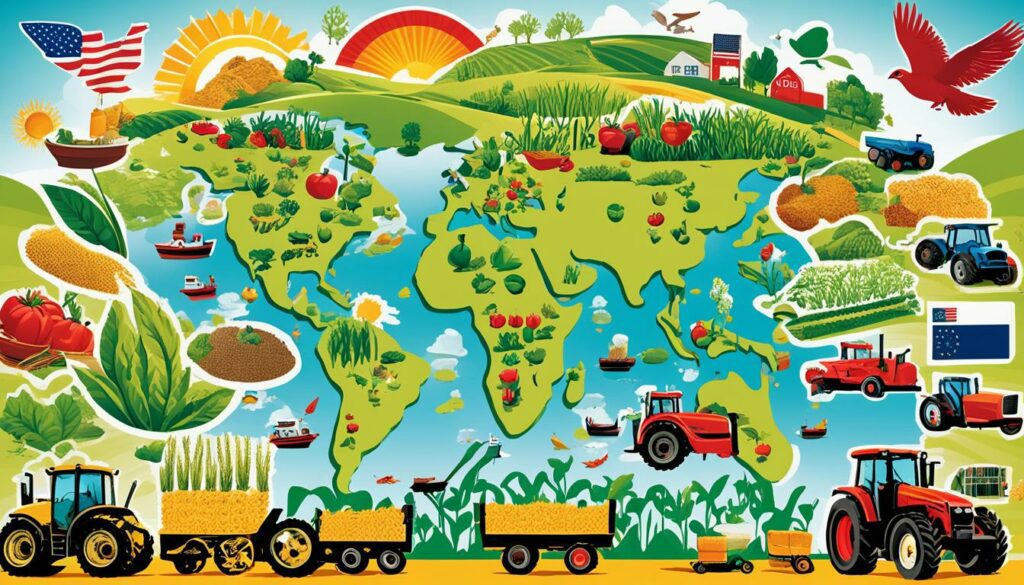
To win in the global market, it’s important to know what products are in demand. Fruits, tree nuts, oilseeds, and grains like rice and wheat are highly sought after. Their exports make up over 40% of their market value. It’s crucial to match your products with what the market wants.
Engaging with programmes like the Agricultural Export Market Challenge can help. In the 2023-2024 year, 15 minority-serving schools got involved. This gave students a chance to learn about real-world *agricultural export market opportunities*. These programmes are free and help students and businesses learn how to export sought-after products.
| Academic Year | Institution Participation |
|---|---|
| 2021-2022 | 14 |
| 2022-2023 | 16 |
| 2023-2024 | 15 |
In conclusion, using what we learn about *agricultural market opportunities* is vital. Focusing on strong export markets and knowing what to export helps businesses grow in the global market.
Exporting agricultural products comes with a set of tough challenges. A key issue is dealing with the world’s changing commodity prices. For example, from 2019 to 2023, export values for items like basmati rice and processed fruits changed a lot. This shows how unpredictable the prices of these items can be.
There’s also the challenge of understanding and following complex export rules. Newcomers find these rules and standards overwhelming. But, knowing and following them is crucial to avoid any legal trouble and to run the export business smoothly.
Moreover, studying the export market deeply can help overcome these challenges. This kind of analysis shows what the market wants, helping exporters adjust their game plans. Take the Agricultural Export Market Challenge by the USDA, for example. It’s a great chance for students to tackle real-life obstacles. This event, which happens online over several weeks in Spring 2024, lets teams of students suggest ways to improve U.S. agricultural exports.
The export value for farming and related products has gone up. It rose from 23,655.07 million USD in 2019-20 to 39,296.04 million USD in 2022-23. This increase shows the field’s potential but also its instability. By facing these challenges, people learn to handle the hurdles in global agriculture trade and shine in the world market.
To boost the export chances of U.S. farm goods, a mix of approaches is needed. This includes the smart use of trade deals and making supply chains work better. These two areas can really improve how America does in the world market.
Trade deals are key for making it simpler to sell farm goods abroad. When the U.S. joins these pacts, it gets perks like lower taxes, more market access, and fewer barriers. The U.S. saw a big jump in farm exports, reaching $196 billion in 2022, thanks to these deals.
In some cases, good trade talks have led to wins for U.S. farmers. Vietnam now welcomes U.S. grapefruits, while India cut tariffs on some farm items. Mexico letting U.S. potatoes in is another win. Such deals make selling abroad easier and build strong business links over time.
Making supply chains work well is crucial for farm exports to stay efficient and competitive. Both the U.S. Department of Agriculture and the Export-Import Bank help out a lot. They play big roles in improving how farm goods get to other countries.
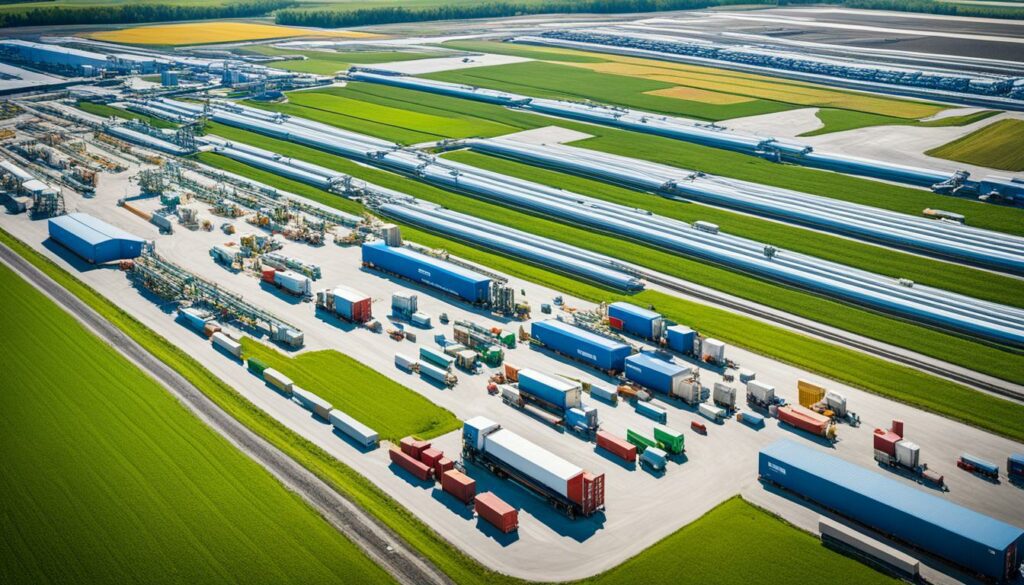
The Export-Import Bank’s help is especially important for supply chain success. Take Monty’s Plant Food Company in Kentucky as an example. They used the bank’s export credit insurance to lower the risk of not getting paid by foreign buyers. This let them give better credit terms and keep their business smooth.
Then there’s Chief Industries, Inc. from Nebraska, which used the bank’s medium-term insurance. Their international sales jumped from 25% to 50%, supporting 45 jobs. This shows clearly how improving the supply chain can help a business grow.
By making the most of trade deals and fine-tuning their supply chains, U.S. sellers can get stronger everywhere. This keeps them in the game, even when the global trading scene changes a lot.
When exporting agricultural goods, having good financial plans is key to success. Export finance strategies cover everything from making a budget to managing risks. They are vital for the financial well-being of exporters.
Export finance is essential for many successful exports. Since the United States is the top agricultural exporter, using the right strategies is very important. The USDA offers important programs like the GSM-102 and FGP. The GSM-102 covers most of the loan and some interest for up to 3 years. It’s great for exporters’ financial planning.
The FGP gives a 95% guarantee on the value of what’s being exported. This kind of help from the government is really good for small and medium businesses. It makes their deals more attractive by offering good payment terms. This is how these financial strategies ensure export activities are financially sound.
Cost management is crucial in face of tough competition in export markets. Businesses must carefully look at interest rates and fees of different financing options. These directly impact how goods are priced and how much profit can be made. They also need to think about risks like the stability of the buyer’s country. These factors really affect the financing costs and decisions.
“Understanding and implementing export finance strategies can be the difference between thriving and struggling in the competitive market.”
Good financial planning covers every step of the export transaction. This includes getting financing before shipping and having enough money after shipping. Different places like banks and the U.S. Commercial Service can help find the best financing options. The GSM-102 Programme, for example, can offer up to 18 months of credit in some countries.
Exporters should keep all their transaction documents for at least five years after they finish paying. This is to make sure they follow CCC rules and can handle any financial checks.
| Programme | Coverage | Term |
|---|---|---|
| GSM-102 | Up to 98% of principal & a portion of interest | Up to 3 years |
| FGP | 95% of goods & services value | Varies |
To sum up, strong finance plans and careful cost controls are crucial for exporters. They rely on help from government programs and many financial sources. This allows them to keep prices competitive, handle risks, and stay profitable in the global market.
The USMCA has changed how the US trades with Canada and Mexico, making it better for American businesses. Knowing how the USMCA helps and what products are top-sellers can make trading easier.
The USMCA has special boosts for the agricultural sector. For example, it lets more American dairy products into Canada, such as milk, cream, and cheese. This includes lower tariffs on whey and margarine, making it easier to sell these products in Canada from the US.
Also, the USMCA ends certain Canadian restrictions on dairy product sales from the US. It looks at rules around agricultural biotechnology too, like gene editing.
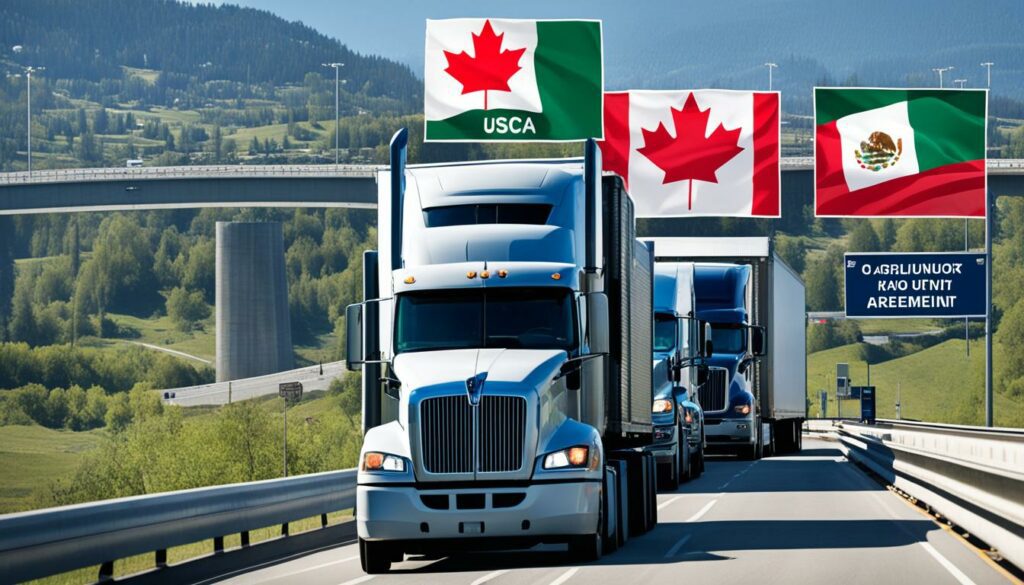
The agreement also cuts down on unfair trade practices and forbids export subsidies or special rules for agricultural goods traded within North America. Now, the way Canada rates US wheat is fairer, ensuring quality regulations are the same for all products.
They’ve also agreed to follow strict rules on handling SPS measures, which focus on protecting plants, animals, and human health from risks related to trade. This makes sure decisions are based on science and are clear to everyone involved.
Dairy is a major hit for exports to Canada and Mexico due to the USMCA. It has given these items lots of new chances. Wheat has seen benefits too, getting treated better, which is great for American wheat farmers.
The deal also sets up rules for new geographic product names. It protects US producers from being blocked from using common names. And Mexico won’t stop certain US cheeses from being sold there, opening up new markets for these cheeses.
Also, there are new commitments that help sell alcohol drinks without running into problems. And food formula secrets are better protected. These steps make trading alcohol and food products easier and fairer for everyone.
All these USMCA rules add up to a more supportive trading setting with Canada and Mexico. This encourages ongoing and growing business in American agricultural products.
The agricultural market has always dealt with changing prices, making it hard for traders. Between 2005 and 2017, maize and wheat prices jumped often. These changes were mainly due to new trade policies. It’s very important to manage these price changes to keep the market steady.
A big study looked at how trade policies affect wheat and maize prices. Wheat and maize are very important around the world. By looking at future prices each day, researchers got a better picture of how prices move.
One big finding was that having enough stock can help lower price jumps. This is because more stock means less worry about future prices. So, keeping enough stock can make prices more stable after big supply or demand changes.
| Commodity | Trade Policy Change | Effect on Price Volatility |
|---|---|---|
| Wheat | Restrictive Export | High Volatility in Low Stock Periods |
| Maize | Liberal Import | Moderate Volatility |
| Wheat | Stockholding | Reduced Volatility |
| Maize | Restrictive Export | Increased Volatility |
It was also found that watching commodity prices is key. The FAO Food Price Index shows prices around the world. It jumped a lot during policy changes. Another database, FAOSTAT, tracks prices in 160 countries each year.
Commodity prices go up and down due to many things. This includes how much is available, needs, money changes, oil prices, weather, and trading rules. For example, in May 2022, the World Bank saw a major price rise. This shows that managing these changes is really important.
This article has shown that exporting agricultural products well requires a detailed plan. Doing good market research, following export laws, and using the latest logistics technology are key. The distance U.S. agricultural exports travel has gone up, showing how vast international trade in this area is.
The idea of distance elasticity tells us how shipping costs for farm items stay high, even with new tech. But, tech has cut down shipping costs for items that can go bad, helping trade worldwide. Since the early ‘60s, the distance U.S. horticultural exports can travel has increased by 40%. This growth also applies to meat exports, thanks to improvements in moving goods.
Yet, challenges exist. Moving goods accounts for 30 to 40 percent of their value for sale, hitting profits, especially for fruits and vegetables. The mix of trading perishable and not-so-perishable goods affects growth differently. This is because each type benefits from certain tech and less strict rules.
Poorer countries are closely watching WTO talks, where the help they get isn’t as much as richer nations. This is big because helping these countries sell more matters a lot. To do well, exporters need to steer through these complex challenges wisely.
Entering the agricultural export market means knowing the basics and finding potential markets. It’s about following international rules for a smooth entry into the world market.
The U.S. is exporting more agricultural goods, like grains, soybeans, and meats. It’s working closely with Canada, Mexico, the EU, and East Asia.
Doing market research helps identify where to sell and what people there like. This helps sellers make products that fit what buyers want.
Export regulations mean knowing international trade laws, safety rules, and trade agreements. This keeps your export business legal and running well.
Not all exports need a licence. Check with the Bureau of Industry and Security and the U.S. Department of State. They’ll tell you when a licence is needed, depending on the goods you are exporting.
The USDA helps find buyers abroad and offers help with global marketing and trade shows. They also share tools for finding the best export markets.
These rules focus on trading objects that might have both civilian and military uses. Knowing these regulations is important to handle all types of exports correctly.
Creating a good Export Compliance Programme and keeping detailed records are key. Also, always check who you are selling to, to avoid breaking any export laws.
New markets and products in high demand offer great chances for growth. Recognising and seizing these opportunities is essential for export success.
Dealing with changing prices, rules, and international obstacles can be hard. However, carefully looking at the market can help solve these problems and make trade smoother.
Using trade deals and improving how goods move are important. These steps make exporting cheaper and more effective, making you stronger in the global market.
Think about the costs of getting into a market, handling money from different countries, and setting the right prices. Use financial tools for international trade to keep making money.
The USMCA helps the U.S. by making trade with Canada and Mexico more stable. By understanding this deal, exporters can do better in these markets.
Knowing about price trends and protecting yourself, with things like hedging, is crucial. This helps keep the market balanced and your business strong.